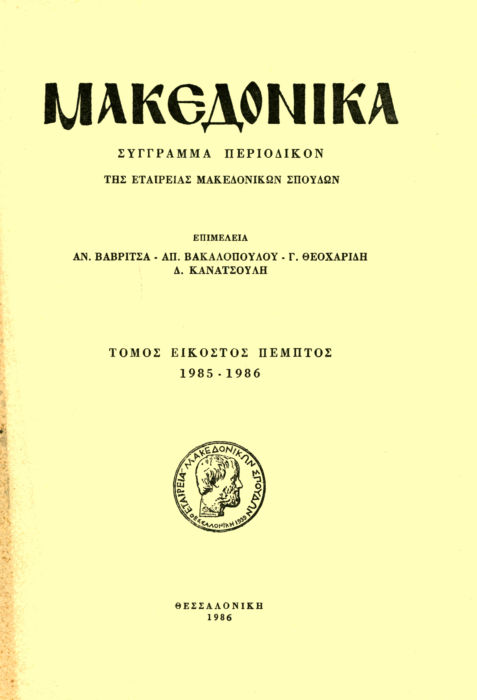Khans and caravanserais from Thessaloniki to the town of Serres and its surroundings from 1774 to 1913
Abstract
The planning of the merchant routes, with the creation of common
courses and stations during the itinerary, started very early. During the reign of the Achaeminidae (6-5 C B.C.) there were the «εμπορία» and the «καταλύσεις» on the large routes and the «καταγώγια» or «δημόσιακαταγώγια » in the towns. The existence of the stations is known since the 7 C under the name of «πανδοκεία» (hostelries). During the Roman Empire this planning was greatly improved. Theree was a network of «πανδοχείωνσταθμών» (inn-stations) in the towns or in crucial spots on the roads. During the Byzantine era apart from the «ξενοδοχεία» (inns), the «ξενώνες» (hospices) and the «πανδοχεία» (hostelries), there were the «ταχυδρομικοίσταθμοί » (post houses).
The planning of the merchant roads was especially developed in the Islamic world, where two were the most well known stations: the caravanserai and the «koursoumli khan». The first is an indvidual building, with a rectangular plan and it is not incorporated in the already existing civil net. The second, because of its incorporation in it, has a polygonal plan form. In the Balkans, both these types of stations—khan and caravanserai— have an architectural aspect, which can be considered a development of the corresponding types of Anatolia.
Specifically in the Greek area that we are examining (from Thessaloniki to the town of Serres and its surroundings) and in the particular period (1774- 1913) we are distinguishing three basic typos of stations during the itinerary:
1. The caravanserais (big Turkish khans) in the large urban centres and the course of the merchant routes.
2. The common khans of the town, which are divided into two classes:
a. The typical merchant khans, built usually in large merchant centres.
b. The simple folk or khans for the animals, in smaller provincial
centres.
3. The rural khans, built out of towns, in villages or in the course of the merchant routes. In tnis class we have two different types:
a. The rural khan with courtyard.
b. The rural khan without courtyard.
Generally the «stations» of the particular region under examination, with the exception of the Caravanserai of Thessaloniki, have not the defence system of the corresponding buildings in other regions of the Ottoman Empire. The
main reason ma> be the political and economical situation of this region at this period: because of its particular geophysical nature and the close supervision by the Turkish sovereigns (Vakalopoulos, 1969, p. 478-487: «The jurisdictior of Ismael Bey of Serres in East Macedonia») the predatory incursions in this area were limited in comparison with other regions in Greece.
Especially in the rural khans of the region, we notice a predominance of the first type: rural khan with courtyard. Very rarely, and only in regions more dangerous because of the their geophysical nature, for reasons of security we find the second type: rural khan without courtyard (e.g. at Dervend—today’s Derveni—in the outskirts of Thessaloniki, in the straits of Kresna, on the hill of Dovat-Tepe).
Article Details
- How to Cite
-
Γαβρά Ε. (1986). Khans and caravanserais from Thessaloniki to the town of Serres and its surroundings from 1774 to 1913. Makedonika, 25(1), 143–179. https://doi.org/10.12681/makedonika.226
- Issue
- Vol. 25
- Section
- Articles

This work is licensed under a Creative Commons Attribution-NonCommercial-ShareAlike 4.0 International License.
Authors who publish with this journal agree to the following terms:
- Authors retain copyright and grant the journal right of first publication with the work simultaneously licensed under a Creative Commons Attribution Non-Commercial License that allows others to share the work with an acknowledgement of the work's authorship and initial publication in this journal.
- Authors are able to enter into separate, additional contractual arrangements for the non-exclusive distribution of the journal's published version of the work (e.g. post it to an institutional repository or publish it in a book), with an acknowledgement of its initial publication in this journal.
- Authors are permitted and encouraged to post their work online (preferably in institutional repositories or on their website) prior to and during the submission process, as it can lead to productive exchanges, as well as earlier and greater citation of published work (See The Effect of Open Access).




